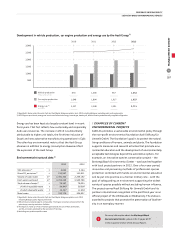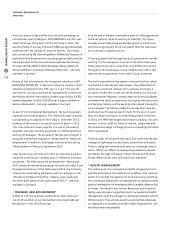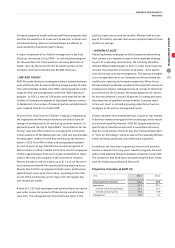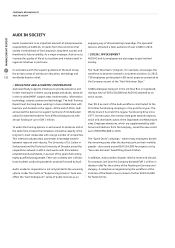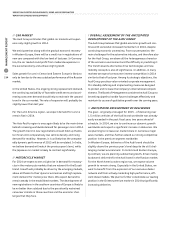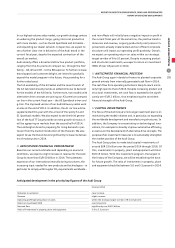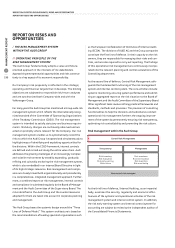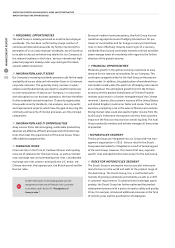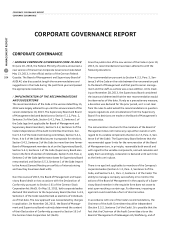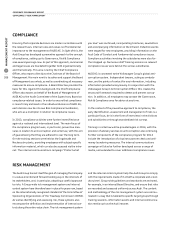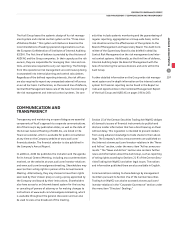Audi 2013 Annual Report Download - page 200
Download and view the complete annual report
Please find page 200 of the 2013 Audi annual report below. You can navigate through the pages in the report by either clicking on the pages listed below, or by using the keyword search tool below to find specific information within the annual report.
REPORT ON EXPECTED DEVELOPMENTS, RISKS AND OPPORTUNITIES
REPORT ON RISKS AND OPPORTUNITIES
MANAGEMENT REPORT
197
A
//
OPERATING PRINCIPLE OF
OPPORTUNITIES MANAGEMENT
We aim to ensure the sustained success of the Audi Group and
the consistent implementation of our Strategy 2020 by effec-
tively managing risks from our business activities and at the
same time identifying and exploiting entrepreneurial opportu-
nities to our best advantage.
With that in mind, we continually analyze the international
context of our business model so that trends and changes in
key factors, such as the market, technology, society and envi-
ronment, are recognized early on and their potential conse-
quences for Audi are deduced. Opportunities management is
integrated into the operational and organizational structure of
the Audi Group and is closely aligned with our strategic objec-
tives. Medium and short-term potential opportunities are
identified and operationalized by the divisions.
//
INTEGRATED INTERNAL CONTROL AND RISK
MANAGEMENT SYSTEM FOR THE FINANCIAL
REPORTING PROCESS
The financial reporting section of the internal control and risk
management system comprises measures designed to ensure the
complete, prompt and accurate communication of all informa-
tion needed for the preparation of the financial statements of
AUDI AG and the Audi Group, and of the Combined Management
Report of the Audi Group and AUDI AG. The objective is to
minimize or eliminate altogether the risk of accounting and
reporting errors and of external reporting.
The Audi Group accounting system is a fundamentally decen-
tralized organization. In individual instances, the subsidiaries’
accounting departments may pass on tasks to AUDI AG on the
basis of service agreements. The individual financial state-
ments of AUDI AG and the subsidiaries are prepared in compli-
ance with the national accounting standards applicable in each
case and then transferred to a Consolidated Financial Statement
in accordance with IFRS. To ensure data security, data trans-
ferred to Group Accounting at AUDI AG is protected using a
commercial encryption product.
The Audi Group accounting guideline assures uniformity in the
recognition and measurement principles based on the IFRS rules
applicable to the parent company. Further Group-wide account-
ing standards define the reporting scopes and the consolidated
companies included in the Consolidated Financial Statements,
as well as the application of statutory requirements. The prop-
er reporting of intra-Group business transactions is regulated
in detail by proven instruments and processes such as the recon-
ciliation of balances between the Group companies.
The individual financial statements prepared by our subsidiaries
are analyzed and validated at Group level. The reports prepared
by the independent auditors and the findings of the concluding
discussions with representatives of the individual companies are
considered at this point. The plausibility of the individual finan-
cial statements and critical individual matters concerning the
subsidiaries are also addressed.
Significant instruments of control, such as the “dual control
principle,” the separation of functions and systematic plausibility
checks on a manual and automatic basis, are used in the prepa-
ration of the Group companies’ individual financial statements.
In addition, Group Auditing examines the regularity of the finan-
cial reporting process for domestic and foreign companies.
Furthermore, the Audi Group is connected to Group Accounting
at Volkswagen AG, Wolfsburg, through the joint use of the
Volkswagen consolidation and corporate management system
(VoKUs) and ongoing information sharing. This approach assures
the consolidation and analysis of data from both Accounting
and Controlling. The system also includes central master data
management and serves as a uniform reporting system. VoKUs
offers a high degree of flexibility if changes to the legal frame-
work need to be incorporated. Data consistency within the
financial reporting process is ensured by systematic validation
functions at multiple levels, such as checks for completeness
as well as plausibility checks on content.
//
RISK EARLY WARNING SYSTEM IN COMPLIANCE
WITH GERMAN ACT ON CONTROL AND
TRANSPARENCY IN BUSINESS (KONTRAG) AND
MONITORING OF EFFECTIVENESS IN COMPLIANCE
WITH GERMAN ACCOUNTING LAW MODERNIZATION
ACT (BILMOG)
Pursuant to the German Stock Corporation Act (AktG), risk
management is subject to wide-ranging statutory require-
ments. The obligations of the Board of Management concern-
ing the early identification of risks that threaten the Company
as a going concern are governed by Section 91, Para. 2 of the
German Stock Corporation Act (supplemented by the German
Act on Control and Transparency in Business [KonTraG]). In
addition, pursuant to Section 107, Para. 3 of the German Stock
Corporation Act (supplemented by the German Accounting Law
Modernization Act [BilMoG]), the Audit Committee of the
Supervisory Board is obliged to consider the effectiveness of the
risk management system (RMS) and internal control system
(ICS). As well as identifying individual risks, this necessitates a
comprehensive systemic approach, in particular taking account
of the measures for managing risks using the corresponding


